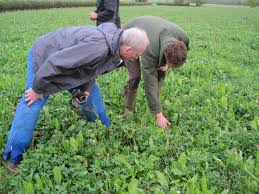Cover / catch crops in orchards and vineyards.

MOMENT OF INNOVATION..
INNOVATION STATUS.
A catch or cover crops are grown between rows of main crops in orchards and vineyards or between periods of regular production to prevent erosion. Adding cover/catch crops to crop rotations helps improve soil quality, reduce soil erosion, enhance nutrient cycling and water holding capacity, and as a result, potentially increase crop yields.
Catch crops may sequester carbon on farm, and may extract plant-available N unused by the preceding crop ,thereby reducing N2O emissions and amount of fertilizer N that needs to be added. Nitrogen-fixing crops (e.g., legumes) transfer atmospheric nitrogen into the soil.
Fewer inputs of both fertiliser and water may thus be necessary. Because the crop is ploughed into the soil the captured organic matter is added to the soil.
Part of it will break down, but effective OM breaks down more slowly.
A catch or cover crops are grown between rows of main crops in orchards and vineyards or between periods of regular production to prevent erosion.
Adding cover/catch crops to crop rotations helps improve soil quality, reduce soil erosion, enhance nutrient cycling and water holding capacity, and as a result, potentially increase crop yields.
Catch crops may sequester carbon on farm, and may extract plant-available N unused by the preceding crop ,thereby reducing N2O emissions and amount of fertilizer N that needs to be added. Nitrogen-fixing crops (e.g., legumes) transfer atmospheric nitrogen into the soil.
Fewer inputs of both fertiliser and water may thus be necessary. Because the crop is ploughed into the soil the captured organic matter is added to the soil.
Part of it will break down, but effective OM breaks down more slowly.


